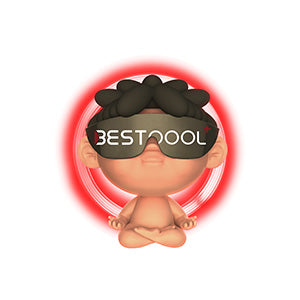Introduction
Regular cycling has several health perks, from improving heart health to lowering the risks of obesity and diabetes. But, the wear and tear associated with cycling-sore muscles, aching joints, and injuries—can hinder cyclists from fully enjoying the benefits of the activity.
So, let me introduce you to Red light therapy - a safe, non-invasive, and effective solution for cyclists. It helps you recover faster, train harder, and improve your overall health.
Research has suggested that red light therapy can lower inflammation, promote cell repair, and boost energy production. This directly contributes to the health advantages associated with cycling, ensuring a healthy heart, an ideal weight, and a focused mind. Overall, this therapy can help cyclists enjoy the complete physical and mental benefits of their favorite activity.

This article is focused on how red light therapy is beneficial for cyclists. Give it a read now!
Understanding Red Light Therapy: How it Works
Mitochondria are like powerhouses that generate energy. But sometimes, those factories slow down, particularly as we age. This is where red light therapy comes in; it helps your body produce more energy by stimulating your mitochondria and thus increases the production of ATP (which transports energy throughout the body). Compared to most other types of cells, muscle cells have more mitochondria because even small muscle movements require energy. This explains why red light therapy works so well on muscle tissue.
The following are some ways that red light therapy may enhance the general health and well-being of cyclists:
- improves blood flow
- enhances the development and strength of muscles
- alleviation of pain
- improves the healing of muscles
- increases the synthesis of collagen
- encourages faster healing from injuries
- boosts stamina
- lessens tiredness
- Lessens cell inflammatory response.
How is Red Light Therapy Beneficial for Cyclists?
- ReducesInflammation:
RLT helps reduce inflammation, speeds up recovery from injuries, and keeps you on your bicycle with minimal discomfort. It's great for cyclists suffering from tendonitis or muscle strains.
Studies have indicated that applying red light to muscles before or after exercise can enhance your performance in sports or other physical activities. Another review also demonstrated that red light therapy may help reduce oxidative stress and inflammation in muscle biopsies.
Various clinical trials have found that red light therapy can be effective in treating inflammation and pain associated with exercise-induced muscle soreness. Pre-exercise red light therapy might enhance athletic performance and speed recovery from muscle strain.
- ImprovesMuscle Recovery:
RLT not only eases inflammation but also fights muscle fatigue, ensuring you bounce back stronger after every ride.
Red light helps in muscle recovery by increasing circulation and oxygenation, as well as cellular regeneration, all of which have long been shown to treat post-exercise muscle soreness, fatigue, and stiffness.
Apart from this, research also indicates that red light therapy may reduce muscle damage and oxidative stress, both of which are important barriers to muscle recovery.

- Reduces Muscle Soreness
Numerous trials conducted on red light therapy indicate that it can reduce muscle soreness, which is another advantage that cyclists can get from receiving this therapy.
Research carried out to determine the effectiveness of RLT on muscle recovery suggested that those who received RLT right after exercise experienced less muscle soreness, muscle strength loss, and range-of-motion impairments.
Another study on college athletes found that RLT significantly (and safely) shortened the recovery period (nearly twice as fast as those who didn't receive the treatment) for college athletes with a variety of injuries.
- Enhanced Performance
RLT improves mitochondrial function and energy levels, giving you the extra push to reach new heights. Photobiomodulation activates your mitochondria, which is an energy reservoir inside your muscles. This energy surge leads to improved performance, better stamina, and increased endurance. It has also been shown that applying red light therapy to the muscles during rest periods and after the most strenuous exercise increases resistance to muscle fatigue. Also, it has been shown to lengthen the exercise session and increase the distance covered during cardiopulmonary exercise tests.
- Injury Prevention:
Cycling is all about enjoying the ride for years to come, and RLT helps! It improves your tissue strength, flexibility, and overall resilience. It acts as your shield against future injuries, keeping you pedaling with confidence.
Studies have shown that it increases collagen production, making your connective tissues stronger and lowering the risk of sprains and tears. Also, this therapy improves your blood flow and flexibility, making your body adapt and go strong on those long rides. For some cyclists, minor injuries or even chronic conditions can make cycling challenging, and red light therapy has shown promising results in healing injured muscles and other tissues.
Red light therapy can promote wound healing, and it's beneficial for cyclists managing existing injuries or being susceptible to cuts and scrapes during their adventures. Another study examined the effect of red light therapy on tendinopathy-associated pain. The researchers concluded that RLT reduces pain by improving blood flow to the injured area. This promotes the healing process by breaking the pain-spasm-pain cycle.
Are there Any Side Effects or Drawbacks?
Although red light therapy seems to be very well-tolerated and unlikely to cause side effects, whether it can benefit all people remains controversial. One challenge that researchers have had gathering results from studies on red light therapy is pinpointing which light ranges are best for treating different health conditions and improving overall well-being.
Bottom Line
There is an optimal dose of light for every particular application, and in the case of red light therapy, lower doses are often found to be relatively more effective than higher doses. Keep in mind that seeing results from red light treatments might take patience, and that responsiveness is likely to vary. Be sure to use high-quality Bestqool red light therapy devices to avoid any adverse effects.
References
- Peserico, C. S., Zagatto, A. M., & Machado, F. A. (2019). Effects of Endurance Running Training Associated With Photobiomodulation on 5-Km Performance and Muscle Soreness: A Randomized Placebo-Controlled Trial. Frontiers in Physiology, 10.
https://doi.org/10.3389/fphys.2019.00211
- Ferraresi, C., Kaippert, B., Avcii, P., Huang, Y., Bagnatto, V. S., Parizotto, N. A., & Hamblin, M. R. (2015). Low level Laser light Therapy Increases Mitochondrial Membrane Potential and ATP Synthesis - C2C12 Myotubes with a Peak Response at 3–6 h. Photochemistry and Photobiology, 91(2), 411-416.
https://doi.org/10.1111/php.12397
- Borssa, P. A., Larkiin, K. A., & True, J. M. (2013). Does phototherapy increase skeletal muscle contractile function and post-exercise recovery? A systematic review. Journal of Athletic Training, 48(1), 57–67.
https://doi.org/10.4085/1062-6050-48.1.12
- Ferraresi, C., Huang, X., & Hamblin, M. R. (2016). Photobiomodulation in human muscle tissues: An advantage for sports performance? Journal of Biophotonics, 9(11-12), 1273-1299.
https://doi.org/10.1002/jbio.201600176
- Heiskannen, V., & Hamblin, M. R. (2018). Photobiomodulation: Lasers vs Light Emitting Diodes? Photochemical & Photobiological Sciences: Official Journal of the European Photochemistry Association and the European Society for Photobiology, 17(8), 1003.
https://doi.org/10.1039/c8pp00176f














 Small
Small

 Moderate
Moderate

 Moderate
Moderate

 Moderate
Moderate

 Full
Full



